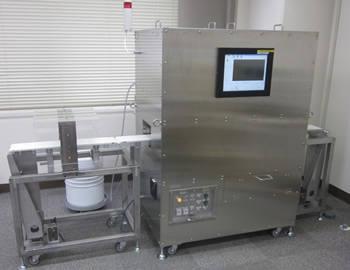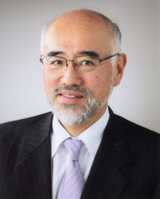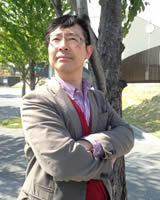
ここからコンテンツです。

The Trick of Finding Contamination

One of the major appeals of Toyohashi University of Technology (Toyohashi Tech) is that the researchers’ eyes can be seen to shine with confidence and a sense of fulfillment. We believe they do so because the objective of engineering research is to promote the happiness of all humanity. For example, we feel happy when we eat something delicious. For the happiness to continue, contamination cannot be allowed. Thus, to study and endeavor to prevent contamination is to promote the happiness of all of the people in the world. Dr. Saburo Tanaka, professor of Environmental and Life Science Engineering at Toyohashi Tech, is taking an unconventional approach to the challenge of preventing metal contamination.
By Yoshio Watanabe
In Tanaka’s laboratory, a method is being studied in which strong magnetism is applied to food to magnetize the metal fragments inside, so that these metals can then be detected by sensing their magnetic fields using a high-sensitivity sensor, or SQUID (Superconducting Quantum Interference Device)1. A functional system of detecting contaminants with this method has already been completed, and has shown excellent metal detection ability in food factories. The researchers in Tanaka’s laboratory are currently working to improve the performance of this system so that even small metal fragments can be detected.
The key to improving performance is to more effectively differentiate between actual signals and noise. Metal fragments are not the only sources of magnetic fields, rather space is filled with many magnetic fields generated from different sources. For example, the Earth is a giant magnet, and it emits geomagnetism. In addition, if electricity is flowing nearby, a magnetic field is generated. The aforementioned high-sensitivity sensor device requires a strong magnet to be placed close to the sensor in order to magnetize the metal fragments.
Magnetic fields that originate from sources other than the metal fragments are called noise. The fields of large metal fragments can be identified over such noise, but those of smaller fragments are masked by the noise and are thus difficult to detect. Even strongly magnetized metal fragments will have small magnetic fields if the fragments are small in size.

To reduce the impact of noise as much as possible, the sensor is placed inside a square metallic box designed so that food can be tested as it passes through this box. The box is made of 2 mm iron-nickel alloy plates. Magnetic fields have strong affinities to this iron-nickel alloy. Thus, magnetic fields around the sensor are concentrated on the walls of this box. In contrast, magnetic fields that pass through the box are decreased significantly. Furthermore, at Tanaka’s laboratory, this box is surrounded by another box made of the same iron-nickel alloy, which is itself inside of another box, in order to maintain the high sensitivity of the sensor.2
The external magnetic fields primarily converge toward the outer box, and even if a weak magnetic field extends inside the first box, it is converged by the second box. Similarly, if remnants of the magnetic field exist inside the second box, they are further converged by the innermost box. In this system, the high-sensitivity magnetic field sensor is installed in the space in which the external magnetic fields are reduced as much as possible. If highly magnetized metallic fragments enter this box, even small fragments could be identified with very high probability even if they were contained in cheese or wrapped in aluminum foil.
To accurately detect even smaller metallic fragments, digital filters have also been used. Magnetic fields detected by the sensor are expressed as fine waveforms, but if the sensitivity is increased, signals from metallic fragments become mixed with noise, making them difficult to identify. A digital filter can be used to accentuate these signals.
The digital filter used in this method is a computational program rather than a physical device. It is applied much like a filter and has the effect of sharpening the blurry outlines. Using a technology called “moving-average processing,” it detects signals that would otherwise be masked by noise. However, in food factories, foodstuff is transferred at a speed of 20 m/min on a conveyer belt; computing systems that can perform real-time calculations are necessary to keep up with this speed. This technique is possible since computers with such capabilities have become available.
The fundamental mechanism of the high-sensitivity magnetism sensor, SQUID uses the property of superconductivity. Since the sensor does not work unless it is in a superconducting state3, it must be kept at a very low temperature at all times; thus, it is equipped with a device that provides a constant stream of liquid nitrogen. Its principal is quite interesting on its own, but it will not be presented it in this article due to the limited space.
By the way, when watching a magic trick involving a coin on a variety show on television, even if one stares closely, one cannot figure out the trick. Modern magic cannot be performed with a single trick but is instead achieved through multiple layers of tricks. Similarly, this technology, which can accurately identify small metal fragments of about 300 microns (invisible to human eyes) in cheese that is passing through at a speed of 20 m/min, also involves a careful combination of multiple “tricks” of modern technology, such as a magnetic sensor, a triple-layered box, a strong magnet, and a digital filter. In tests of this equipment for industrial purposes that use the same principle, its sensitivity has proven to be so high that metal fragments less than the width of two human hairs could be detected.
Researchers with a wide range of knowledge and technology determine what combinations of “tricks” can achieve the desired results, thanks to their superhuman creativity. Because of their achievements, television stations can safely broadcast magic shows and food factories can safely ship their products. There are no elements that can interfere with our happiness. Therefore, the eyes of Toyohashi Tech researchers still shine today, with confidence and the sense of fulfillment.
Technological Remarks by Dr. Saburo Tanaka
- 1 When microscopic metal fragments in food are magnetized by a powerful and permanent magnet with a magnetic flux density of 0.3 T (Tesla) or higher, the magnetic domain in the metal grows and expands, lowering the slope of the magnetization curve, and leading to the saturated state. A magnetic domain that is grown in this manner does not return to its original conditions easily even if the magnetic field is removed; instead it remains in the metal as residual magnetization. The residual magnetization is weak, at several pT (picotesla, 10-12), but it can be detected with a high-sensitivity magnetic sensor: SQUID (Superconducting Quantum Interference Device).
- 2 In magnetic shield technology, materials with high permeabilities are used.
- 3 Superconducting state: a state in which electrical resistance is reduced to zero by sufficiently lowering the temperature. Technically, three phenomena are known to occur in a superconducting state: 1) “perfect conduction,” in which the electrical resistance becomes zero, 2) the “Meissner effect” (perfect diamagnetism) that prevents magnetic flux from entering the inside of superconductor, and 3) “quantization of magnetic flux” in which only magnetic fluxes that are integer multiples of the flux quantum (Φ0 = h/2e: 2.07 × 10-15 Wb) can exist inside of the superconducting ring. In the high-sensitivity magnetic sensor SQUID, the third phenomenon, “quantization of magnetic flux,” is utilized. When a SQUID is placed inside of a weak magnetic field, magnetic flux attempts to enter the thin-film superconducting ring that constitutes the SQUID. However, because of the quantization of magnetic flux, only magnetic fluxes that are integer multiple of the magnetic flux quantum can exist; thus, to prevent this flux from entering, the superconducting ring generates a shielding current. A gate on the superconducting ring of SQUID that is called the Josephson junction controls the current. If the current is greater than the designated current (the critical current of the junction), the gate generates a voltage. This gate converts the shielding current into a voltage, enabling the measurement of weak magnetic fields. In other words, conversions occur in the order of changes in magnetic field → changes in shielding current → changes in voltage. However, the SQUID ring detects magnetic fields as zero when it is cooled and becomes superconducting; thus, it cannot be used to obtain accurate absolute measurements. Instead, it only measures magnetic field changes. Its sensitivity is remarkable: magnetism that is 1/100 million to 1/1 billion of geomagnetism can be measured. Superconductivity was discovered by Dr. Kamerlingh Onnes of Leiden University, Netherlands, in 1911. Initially, this phenomenon could only be confirmed when materials were cooled down to 4.2 K, which is close to absolute zero. However, since then, materials have been discovered that become superconductors at about 90 K. With the device used in this study, a high-temperature superconductor is used, which becomes a superconductor at 90 K or higher.
異物混入発見のタネあかし
豊橋技術科学大学の大きな魅力の一つは、研究者たちのまなざしが自信と充実感にあふれていることです。それは、工学系の研究は人類の幸せの追究から生まれるものだからだと思います。ところで私たちは「おいしいものを食べている時」とても幸せを感じます。幸せな時間がいつまでも続くためには、絶対に異物混入なんてあってはいけないことです。異物混入防止の研究は、世界中の人たちの幸せのための研究です。
技科大には金属の異物混入防止を従来にない発想で解決しようとチャレンジしている研究者がいます。
環境生命工学系教授 田中三郎氏です。
田中研究室では、食品に強い磁気を当てて、中に入っている金属片を磁化させ、そこから出る磁力線を高感度センサーで見つける方法 1を研究しています。その方法で異物を見つける装置はすでに完成していて、食品工場で結果を出しています。今は、さらに小さな金属片でも見逃すことなくチェックできる性能アップに頑張っています。
性能アップの鍵は「ノイズとの戦い」です。磁力線を出すのは金属片だけではありません。眼には見えませんが、空間には様々な磁力線が飛び交っています。たとえば地球も巨大な磁石です。地磁気を発しています。そばを電気が流れていれば磁場ができるし、なにより金属片を磁化させる強力磁石がセンサーのすぐ近くについています。
金属片からの磁力線以外のそういった磁力線をノイズと呼んでいます。大きな金属片なら多少ノイズがあっても判別できますが小さくなるとノイズに埋もれて見つけにくくなります。強力に磁化された金属片でも、サイズが小さいと磁力も小さくなるからです。
できるだけノイズの影響を減らすように、センサーは金属製の四角い箱に入れてあって、食品もその中を通って検査される仕組みになっています。箱は厚さ2ミリの鉄板でできています。正確には鉄とニッケルの合金です。磁力線は鉄とニッケルの合金が大好きです。よってセンサー近くの磁力線はほとんどが箱の壁に集まります。逆に箱の中を通る磁力線はぐっと少なくなります。しかも田中研究室ではその箱の周りを同じ鉄とニッケルの合金の箱でさらに囲い、念のためさらにその外側を同じ箱で囲う構造で高感度センサーを守っています2。
ほとんどの磁力線は外側の箱に収束され、それを逃れたわずかな磁力線もその内側の箱に収束され、もしまだ残っている磁力線があってもさらに内側の箱に収束され、磁力線をとことん減らした空間に磁力線を見つける高感度センサーが付けられています。その箱の中に強力磁石で磁化された金属片が入ってくれば、かなり小さな金属片でも、チーズに入っていようがアルミの袋で包装されていようが、まず確実に見つけられるというわけです。
さらに小さな金属片を確実に見つけるために、「デジタルフィルター」も使いました。センサーによって検出された磁力線は細かい波形で表わされますが、感度を上げると、金属片からの信号もノイズにまぎれて判別しにくくなります。それを際立たせる技術が「デジタルフィルター」です。
「デジタルフィルター」は、物理的な装置というより計算プログラムのことで、フィルターのようにかけて、ぼんやりした結果の輪郭をはっきりさせる効果があります。「移動平均処理」という技術により、ノイズに混じって目立たなかった信号をはっきりつまみあげてくれます。ただし食品工場では食品がベルトコンベアに乗せられて毎分20mというスピードで流れていくので、そのスピードに遅れることなくリアルタイムに計算するコンピュータの演算能力も必要です。その要求に応えてくれる能力を持ったパソコンがやっと普及したからこそ達成できた技術でもあります。
肝心の高感度磁力センサーの仕組みは、超伝導の性質を巧みに使ったものになっています。超電導状態3でないと働かないので常に極低温に冷やしておく必要があり、液体窒素が流れる装置も付いています。その原理も非常に面白いのですが、今回の限られた紙面では伝えきれません。
テレビのバラエティー番組で放送されるコインを使った手品ショーを観て、トリックを見破ろうと目を凝らしてもとてもできません。今の手品はひとつのトリックでできるわけではなく、いくつものトリックを重ねて作られているのだそうです。それと同じように、毎分20mで出てくるチーズなどに300ミクロン程度の肉眼では見えないような金属片が入っているかどうか確実に判別できるというこの技術も、磁気センサーや3重の箱、強力磁石、デジタルフィルターといった現代技術が生んだ数々の“トリック”を絶妙に組み合わせ作られています。同じ原理を用いた工業用の検査装置では、更に高感度で毛髪の太さ2本分の大きさもない金属片も検出できるそうです。
どんなトリックをどう組み合わせれば求める結果が出せるのか、幅広い知識と技術を持った研究者が超人的な発想力で解決しているのです。テレビ局は安心して手品の番組を放送できるし、食品工場は安心して製品を出荷できるのです。私たちの幸せな時間を邪魔する要素はありません。 ということで豊橋技術科学大学の研究者たちのまなざしは今日も自信と充実感にあふれているのです。
(渡辺欣生 エフエム豊橋パーソナリティー)
- 1 食品中の微小金属片は磁束密度0.3T(テスラ)以上の強力な永久磁石で帯磁されると、金属内部の磁区が成長拡大し、磁化曲線の傾斜が小さくなり、ついには飽和状態になります。こうして成長した磁区は磁界を取り去っても容易には元に戻らず、残留磁化として金属内部に残ります。その残留磁化は数pT(ピコテスラ、10-12)微弱ですが、高感度磁気センサーSQUID(Superconducting Quantum Interference Device)で検出することが可能です。
- 2 磁気シールドと呼ばれる技術で、物理定数の透磁率の高い材料が用いられる。
- 3 超伝導状態:極低温にすることで、電気抵抗がゼロになることを指します。より、専門的には超伝導状態では、1.電気抵抗がゼロになる、つまり、“完全導体”の他に、2.内部に磁束が侵入することを妨げる“マイスタナー効果”(完全反磁性)や、3.超伝導のリング内部には磁束量子(Φ0=h/2e: 2.07x10-15Wb)の整数倍の磁束しか存在できないという“磁束の量子化”と呼ばれる、3つの現象が生じることが知られています。
高感度磁気センサーSQUIDでは3つめの“磁束の量子化”現象を利用しています。SQUIDを微弱磁場中に置くと、SQUIDを構成する薄膜超伝導リング内部に磁束が侵入しようとします。ところが磁束の量子化の作用で内部には磁束量子の整数倍の磁束しか存在し得ないので、侵入を妨げようとして超伝導リングには遮蔽電流が流れることになります。SQUIDの超伝導リングにはジョセフソン接合と呼ばれる電流を制限するゲートが配置されており、決められた電流(接合の臨界電流)以上が流れようとすると、そのゲートで電圧を発生するようになっています。このゲート作用によって、遮蔽電流が電圧に変換されて微弱磁場を計測することが可能となります。つまり、磁場変化→遮蔽電流変化→電圧変化というように変換されます。ただし、SQUIDリングは冷却されて超伝導状態になった環境の磁場をゼロと認識するので、絶対値測定は不得意で、磁場変化のみを計測しますが、その感度は驚異的で地磁気の1億~10億分の1の感度を有しています。超伝導現象はオラン,ライデン大学のカマリン オネス先生が1911年に発見し、当初は絶対ゼロ度に近い4.2Kまで冷却しないとこの現象を確認出来ませんでしたが、その後、90K程度で超伝導になる材料が発見されています。この装置では90K以上で超伝導になる高温超伝導材料が使用されています。
Reference
- S.Tanaka, T. Ohtani, Y. Narita, Y. Hatsukade, and S. Suzuki, “Development of metallic contaminant detection system using RF High-Tc SQUIDs for food inspection,” IEEE Trans. Appl. Supercond. Vol. 25, no. 3, June. 2015, Art. ID. 1601004.
Researcher Profile

Dr. Saburo Tanaka studied until Masters level at Toyohashi Tech University, and received his PhD. degree in 1991 from Osaka University, Japan. Since 1987, Dr. Tanaka has been involved in researching high-temperature superconductors at ltami Research Laboratory, Sumitomo Electric Co., Ltd, He was involved in the development of multi-channel high-Tc SQUID systems at the Superconducting Sensor Laboratory between 1991 and 1995. He was also a visiting research associate of Professor John Clarke’s group in the Department of Physics at UC Berkeley from 1996 to 1997.
Currently, Dr. Tanaka is a professor in the Department of Environmental & Life Sciences and a presidential advisor at Toyohashi University of Technology, Japan. He has more than 25 years of research experience in high-temperature SQUID applications, and has published extensively in peer-reviewed journals. Tanaka has filed more than 350 patents in Japan, of which more than 70 were granted by the U.S. Patent and Trademark Office.
Reporter Profile

Yoshio Watanabe is a program producer and caster at “FM Toyohashi,” a radio station in Toyohashi, where Toyohashi Tech is located. Since 2008, he has been broadcasting a program about Toyohashi Tech every Saturday evening and the program is still continuing on the air today. Watanabe has been responsible for spreading public awareness of talented researchers, and has covered over 350 interviews and broadcasts. He has something of an expert in the research of Toyohashi Tech, and has become very proficient at explaining it to the public.
ここでコンテンツ終わりです。
